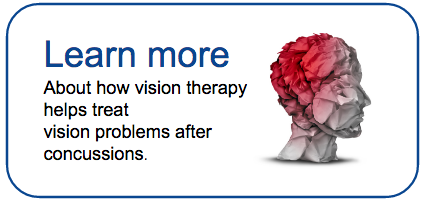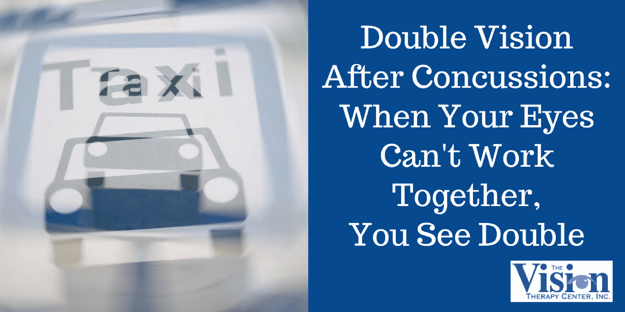
Why do so many people experience double vision after concussions? A concussion will affect your eyes’ ability to work together -- referred to as eye teaming. Double vision is a symptom of poor eye teaming. It can be corrected by training this essential visual skill.
In a previous post on blurred vision and concussions, we explained how the visual system, consisting of your eyes, brain and visual pathways, is amazingly complex. It’s no surprise that a head injury could then result in double vision.
Before we get to how we treat the symptom that is double vision, you should understand the visual skill that has been affected by the concussion.
Defining the Skills That Make Up Functional Vision
To understand double vision, you need to understand eye teaming, which is one of three skill areas that make up functional vision.
Functional vision is how your entire visual system -- the eyes, the brain, the visual pathways -- work together to help you interact with your environment. Functional vision includes the visual skills eye teaming, eye movement and eye focusing.
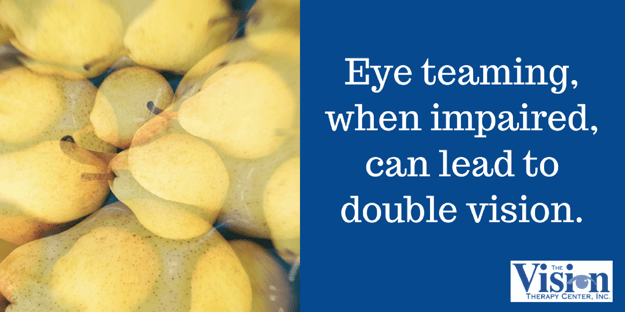
In the case of double vision after a concussion, the visual skill that’s typically affected is eye teaming. Eye teaming occurs when the eyes align to focus on the same point on an object and work together in a coordinated and precise way. Good eye teaming allows efficient, single, comfortable vision and depth perception.
Double Vision After a Head Injury: Impaired Eye Teaming is the Root Cause
Now let’s take a closer look, no pun intended, at the visual skill area referred to as “eye teaming.”
Eye teaming occurs when the eyes align to focus on the same point on an object, resulting in a single image and binocular (two-eyed) depth perception. To see an object in 3D, your eyes send two separate images to your brain. The brain then combines the images into a single, 3D image, resulting in depth perception.
If the two eyes are not both pointed at the same spot, the brain won’t be able to combine the images. When this happens, a person will experience double vision and lose binocular depth perception.
So what can you do to alleviate this symptom and restore your eye teaming skills?
Steps to Recovery From Concussion and Double Vision
Before we get to any treatment methods, it’s important to remember that you need to carefully follow the advice of your physician. They will guide your recovery, and monitor you as the swelling and inflammation subsides.
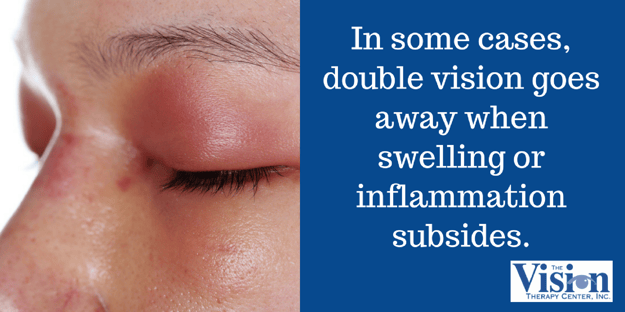
As you heal, the double vision may lessen or end altogether as the swelling or inflammation lessens. With less pressure from the swelling, the area in the brain that controls the eye teaming skill may be able to function normally again.
If your doctor has cleared you to return to normal activity and you’re still experiencing double vision, then it’s time to see a developmental optometrist.
How Developmental Optometrists Treat Double Vision From a Concussion
Developmental optometrists specialize in assessing and improving functional vision. For cases such as vision problems from traumatic head injuries, primary care optometrists will refer patients to a developmental optometrist. The diagnosis and treatment process typically follows these steps:
Step 1: Conduct a functional vision test
A functional vision test includes more than just testing to see if your eyesight is 20/20. A developmental optometrist will test all three of the visual skills areas that make up functional vision. In some cases, all three visual skill areas may be affected, which is why this comprehensive test is required.
Step 2: Develop a plan for treatment
Based on the functional vision exam results, a treatment plan may include one or all of the followings areas:
Prescription lens: Glasses may be prescribed to address eyesight, improve functional vision, or both.
Syntonics: Syntonics involves the use of light therapy to treat functional vision problems. It helps restore balance to the autonomic nervous system, as explained in this article on syntonic phototherapy.
In this video, Dr. Kellye Knueppel explains how it works, and how it has improved the visual skills of patients.
Vision therapy: Through an individualized program of exercises and activities to improve how you use your vision, you can improve the affected visual skill areas. The length of the vision therapy program will vary depending on the extent to which the person progresses.
A treatment plan is geared to where the patient is in the recovery phase. Sometimes in the early stages, we need to go very slowly -- perhaps starting out with syntonics treatment alone, or simply a lens prescription to improve functional vision.
It should also be noted that in some cases, the concussion may have caused permanent injury to the area of the brain that controls eye teaming. In these cases, these treatments may not alleviate the double vision. However, the treatments may help the patient compensate for the loss and/or maximize the other visual skills.
Separating Pre-Existing Vision Problems From Head Injury-Induced Double Vision
We’ve been referencing functional vision problems that occur after an injury. However, you may already have a mild vision problem, and it becomes more severe after the injury. Or you may have had a functional problem that you've gotten better with therapy, but then the injury causes it to come back.
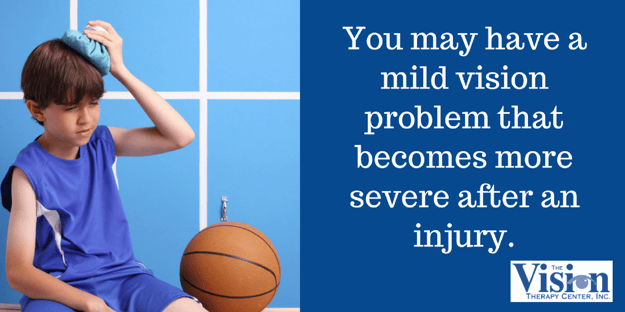
We strongly recommend that you have a functional vision exam to establish your baseline. In the event that you suffer a concussion, a baseline gives us insight into whether it existed prior to the injury. This post details baseline testing -- both in general and for functional vision.
To see if you have any of the symptoms of a functional vision problem, take our Vision Quiz.
Double Vision After a Head Trauma: How to Seek Out Treatment
Before you seek out treatment from a developmental optometrist, first consult with your doctor. We need to know that the swelling has subsided and is not impacting the area responsible for eye teaming. We also have to know if you’re ready to undergo treatment.
Once you have the green light, contact a developmental optometrist, who specializes in functional vision problems. Here’s a link to find one in your area.
Click below to see our website page on vision and concussions. It includes success stories involving patients who have used vision therapy to overcome double vision and other symptoms.

